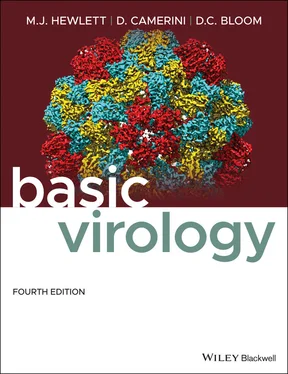Notable persistent viruses include the human herpesviruses, human papilloma and related polyoma viruses, human retroviruses, and two completely unrelated viruses – hepatitis B and hepatitis C viruses – whose chronic infection leads to severe liver damage. The details of the replication of these viruses will be covered in later chapters in Part IV; what is important to consider now is that the persistent mode of virus–host interaction is well suited to small groups of wandering related individuals with only occasional contact with other such groups. Virus persistence insures that virus can survive without infecting new individuals for the long life of the human host, yet virus recrudescence insures that there will be opportunities for virus spread at opportune times.
A detailed analysis of the genes of these viruses, especially those originally appropriated from the host, using procedures outlined in Chapter 1demonstrates both their long association with humans and the considerable evidence for their replicative isolation – again expected for an infectious agent constrained to maintain itself in a small, relatively isolated environment.
Viral diseases associated with acute, severe infection are suggestive of zoonoses
While a pattern of virus infection leading to persistence of infectious virus correlates with the ancient association between humans and specific groups of viruses, those viruses characterized by an acute, severe infection with variable or high mortality rates suggest a virus that either has a primary reservoir other than humans (a zoonosis) or has recently “jumped” from such a reservoir to establish and maintain itself in the human population. Influenza A virus is a typical example of such an acute disease‐causing virus. The primary reservoir for this virus is birds, but its broad host range allows it to establish secondary reservoirs in pigs as well as humans. Not all strains of the virus introduced into the human population are marked by high mortality rates, but occasionally an avian‐ or swine‐adapted strain with high mortality rates can establish itself in the human population with severe and even devastating results. The great worldwide epidemic of influenza (H1N1) in 1918–1919 (also called a pandemic) was the result of a direct transmission of the virus from birds to humans, with subsequent mutation to allow human‐to‐human spread. There are great concerns that recently described avian flu outbreaks (i.e., H5N1), which originated in eastern China, could do the same.
Numerous other examples of zoonotic viruses associated with severe human disease exist. The 2002–2003 SARS (severe acute respiratory syndrome) outbreak was the result of a coronavirus established in animals (probably the bat and/or palm civet) adapting to human spread. The epidemic of Ebola virusdisease, which killed over 11 000 people in West Africa in 2013–2016, whose natural reservoir was probably in bats is another example; others are the sporadic appearance of West Nile virus harbored in avian populations, as well as various insect‐borne encephalitis viruses.
The most devastating virus introduced into the human population from a zoonosis in recent time is the human immunodeficiency virus (HIV), which is the causative agent of AIDS. There are two types of HIV, which differ in sequence by 25%. Both types of virus have been shown to be closely related to retroviruses carried asymptomatically in nonhuman primates in Africa, and they clearly entered the human population through contact with such animals, probably in their use as a delicacy in local cooking. The virus is spread through sexual contact and intravenous drug usage, and, as described in a later chapter, human behavior has favored its establishment as a formidable threat to public health, especially in the developing world.
We can infer that other viruses characterized by their spread as sporadic epidemics with high mortality rates in the human population have had relatively recent histories in human populations. A notable example is smallpox (variola) virus, which is completely adapted to humans, but which requires a large population for its maintenance and spread due to its lack of persistence and its engendering of a strong and lasting immunity. Since related poxviruses are found in many animals maintaining large populations, introduction into humans after the development of agriculture and urbanization can be inferred. The same can be said for polio, measles, Ebola, and other viral diseases, which spread by acute infection and leave an immune population cleared of virus in their path. Indeed, Jared Diamond has made a strong case for such diseases being a critical feature in the development of modern, urban society in his book Guns, Germs, and Steel: The Fates of Human Societies .
PATTERNS OF SPECIFIC VIRAL DISEASES OF HUMANS
While classification of human viruses according to the history of their association with us as host is very useful from an epidemiological and evolutionary point of view, a classification of these viruses by the nature of the disease they cause and its sequelaeis more useful from a medical perspective. Some important viral diseases are classified in this way throughout this section.
Acute infections followed by virus clearing
Colds and respiratory infections
Cold viruses (rhinoviruses, adenoviruses, and coronaviruses) are spread as aerosols. Infection is localized within the nasopharynx, and recovery involves immunity against that specific virus serotype. The vast array of different cold viruses and serotypes ensures that there will always be another one to infect individuals. Although generally these types of respiratory diseases are mild, infection of an immune‐compromised host or a person having complications due to another disease or advanced age can lead to major problems.
The epidemiology of influenzais an excellent model for the study of virus spread within a population. While symptoms can be severe, in part due to host factors, the virus infection is localized, and the virus is efficiently cleared from the host. Flu viruses have evolved unique mechanisms to ensure constant generation of genetic variants, and the constant appearance of new influenza virus serotypes leads to periodic epidemics of the disease. Some of these mechanisms are described in detail in Chapter 15, Part IV. The respiratory distress caused by most strains of flu virus is not particularly life‐threatening for healthy individuals, but poses a serious problem for older people and individuals with immune system or respiratory deficiencies. Some strains of the virus cause more severe symptoms with accompanying complications than others. At least one strain, the Spanish strain of 1918–1919 (H1N1), caused a worldwide epidemic with extremely high mortality rates in the years immediately following World War I.
The disease caused by infection with smallpox (variola)virus is an example of a much more severe disease than flu, with correspondingly higher mortality rates. There are (or were) two forms of the disease: variola major and variola minor . These differed in severity of symptoms and death rates. Death rates for variola major approached 20%, and during the Middle Ages in Europe, it reached levels of 80% or higher in isolated communities. Virus spread was generally by inhalation of virus aerosols formed by drying exudate from infected individuals. Variola virus is unusually resistant to inactivation by desiccation, and examples of transmission from contaminated material as long as several years after active infection were common.
Читать дальше












